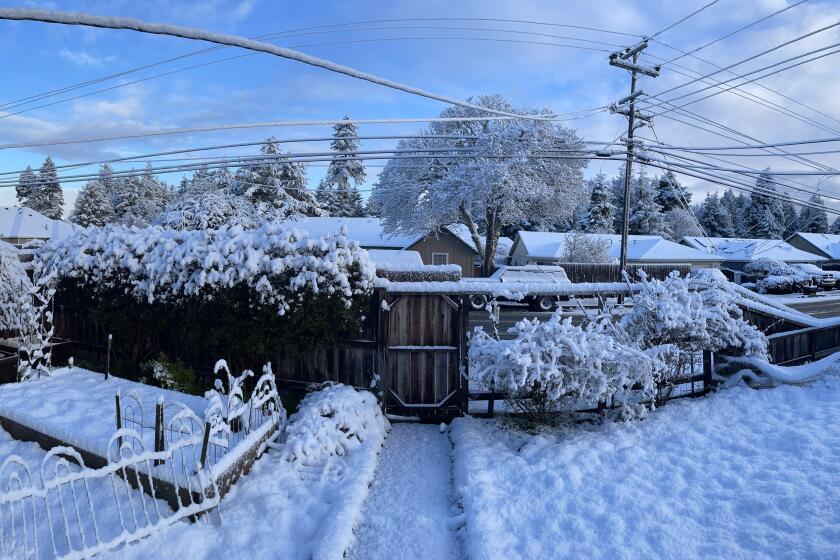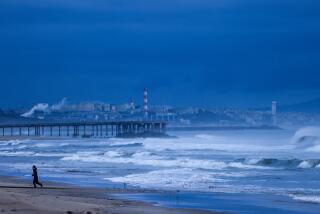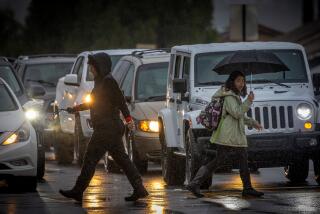Rare weather conditions are fueling California’s ‘major and unusual’ snow, blizzard warning

“All systems go for a major and unusual storm,” the National Weather Service said in its forecast on Wednesday.
The powerful winter storm moving through California is expected to drop heaps of rain, sleet and snow across much of the state, including Southern California, where several feet of fresh powder could fall in the mountains of Los Angeles and Ventura counties at elevations as low as 1,500 feet Thursday into Friday.
The event is unusual even in a winter of unusual events, climate experts say. The state already defied forecasts for a dry winter driven by La Niña when a series of nine atmospheric river storms pummeled California in January — the wettest three-week period on record, according to state officials.
Now, portions of Los Angeles and Ventura counties are under a blizzard warning — only the second such warning ever the weather service is aware of. Should forecasts manifest, the mountain areas could receive the “largest amount of 24- [to] 48-hour snowfall seen in decades,” rivaling a winter storm in 1989, forecasters said.

Daniel McEvoy, a regional climatologist with Western Regional Climate Center, said the rare system is part of a larger-scale circulation pattern in the Western U.S. that has been in place through much of winter and has locked in a lot of cold air.
“This has been one of the coldest winters in many decades for a lot of places,” McEvoy said. “The fact that we’re having another cold storm this winter is not that surprising, but the magnitude — and how the ingredients are setting up to impact Southern California especially — is looking pretty rare.”
The system is being driven by an area of low pressure off the coast of California that is slowly moving south from Canada, he said. Within that main system are multiple “waves of energy” due to the flow of the jet stream, or the air currents in the upper level of the atmosphere that guide weather systems across the globe.
Scenes from across Southern California, where a powerful winter storm dumped heaps of snow and record-setting rain.
Though it is not like the “classic” atmospheric rivers that hit the state in late December and early January, the system will connect with moisture over the Pacific as it moves through California, signaling heavy rain and snow.
“The forecast has a lot of snow, and snow at really low elevations, as opposed to the storms that we saw in early January that had a completely different flow where the jet stream was coming from the west, or even the south, and bringing up warmer air, which led to really high snow levels during that series of storms,” he said.
The effects of the storm are expected to be wide-ranging and potentially dangerous, including road closures, power outages, downed trees and other hazards. Residents are being advised to avoid travel during the brunt of the storm unless absolutely necessary.
Already dumping snow in Northern California, the storm is set to intensify as it moves to Southern California, bringing blizzard warnings to the mountains.
Though Southern California will feel some impacts, it’s far from the only part of the state bracing for snowy weather, with winter storm warnings in areas ranging from the Oregon border to Mexico.
“This is a rare setup for us,” said Brayden Murdock, a meteorologist with the weather service in the San Francisco Bay Area. “If this whole system was pushed a little more off to the east, it probably would have been more of a dry, strong wind event, but since it gets the opportunity to interact with the Pacific, that’s why we’re getting all this moisture on top of it.”
Indeed, it was only months ago when forecasters called for a drier-than-normal winter driven largely by La Niña, a climate pattern in the tropical Pacific.
“It’s got the cold air, it’s got the moisture, it’s got strong winds,” one forecaster said. “It’s an ideal situation for a big weather maker with huge impacts.”
But La Niña is transitioning into a more neutral pattern, said National Weather Service meteorologist Lisa Phillips. The latest seasonal outlook issued by the National Oceanic and Atmospheric Administration now shows equal chances of wetness or dryness in almost all of California through May.
McEvoy, the climatologist, said the moist system speaks to the challenges of long-term forecasting. Since about November, the jet stream has been digging out an area of low pressure that has been persistent over much of the West Coast, he said.
Essential California
Stay up to speed on the biggest stories from the West, in your inbox every morning. Sign up here.
“The atmosphere has gotten locked into this pattern this winter, and it doesn’t look like it’s going to be breaking anytime soon,” he said.
David Sweet, a meteorologist with the weather service in Oxnard, called it a “complex and complicated scenario.”
“It’s bringing all of that cold air down to Southern California; we’re getting the full brunt,” Sweet said.
Forecasts show Southern California mountains could get 6 inches to 5 feet of snow by Saturday, but some of the highest peaks could get up to 8 feet.
“It’s got the cold air, it’s got the moisture, it’s got strong winds,” he added. “It’s an ideal situation for a big weather maker with huge impacts.”
Temperatures were expected to be as much as 20 degrees below normal, and by Wednesday afternoon, snow was already starting to fall in portions of the Antelope Valley, while hail was pounding the pavement in Highland Park and Pasadena. Residents reported a dusting of snow in La Crescenta, and 50-mph gusts battered Thousand Oaks and Agoura.
The biggest effects will be Thursday through Saturday, when Southern California could see several feet of fresh powder in the mountains around Los Angeles.
More to Read
Start your day right
Sign up for Essential California for news, features and recommendations from the L.A. Times and beyond in your inbox six days a week.
You may occasionally receive promotional content from the Los Angeles Times.











